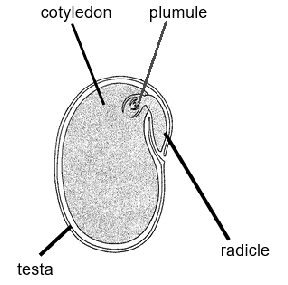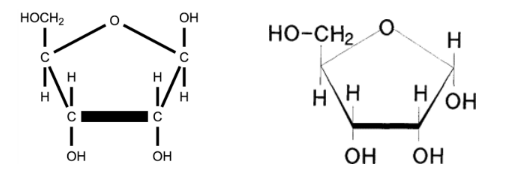Question
Fluids inside unicellular and multicellular organisms allow materials to be moved.
(a) Explain how vesicles are used by cells to move materials.
(b) Describe the transport of carbon compounds such as sucrose and amino acids in phloem.
(c) Outline how food is moved from the stomach to the large intestine.
Answer/Explanation
Answer:
(a)
a. fluidity of membranes allows vesicles to bud off membranes/fuse with membranes;
b. materials taken into cells by endocytosis/vesicle formation;
c. Paramecium takes in food / phagocytes engulf pathogens / another example;
d. materials released from cells by exocytosis/by vesicle fusing with plasma membrane;
e. neurotransmitter released at synapses / protein secretion / secretion from gland cell / another example;
f. movement/transport of materials (inside vesicles) within cells/through the cytoplasm/between organelles/from an organelle to the (plasma) membrane/from the (plasma) membrane to an organelle;
g. movement of proteins from the rough ER to the Golgi / another example;
(b)
a. transport/translocation in (phloem) sieve tubes;
b. flow of sap through pores in end walls/sieve plates;
c. sugar/amino acids are transported dissolved in water/sap;
d. loaded into phloem (companion cells/sieve tubes) by active transport;
e. protons pumped out and sucrose then enters by cotransport;
f. high solute concentration created in phloem/sieve tube;
g. water enters (sieve tube) by osmosis;
h. hydrostatic pressure in sieve tube increases;
i. unloading from sieve tubes in sink/in roots;
j. water leaves by osmosis lowering the hydrostatic pressure;
k. sap movement (in phloem) from higher to lower pressure;
l. movement from source/leaves to sink/roots;
(c)
a. by muscles (contracting);
b. peristalsis/waves of muscle contraction followed by relaxation;
c. longitudinal muscle pushes food along the intestine when it contracts;
d. circular muscle constricts the intestine to ensure movement only onwards/not back to stomach;
e. movement (from stomach to large intestine) via the small intestine/duodenum/ileum;
Question
Plants have widespread influences, from food chains to climate change.
Draw a labelled diagram of the internal structure of a seed.
Plants have widespread influences, from food chains to climate change.
Explain the process of water uptake and transport by plants.
▶️Answer/Explanation
Markscheme
a. radicle/embryo root shown tapering to a root tip
b. plumule/embryo shoot shown with embryonic leaves «in a dicot seed» drawn and labelled
OR
plumule/embryo shoot shown tapering to a shoot tip «in a monocot seed»
c. seed coat/testa shown with a double line
d. cotyledon/endosperm shown as a large structure «for food storage»
e. embryo shown with both embryo root and shoot visible
Accept any dicot or monocot seed
eg:

Award [1] for any of the structure clearly drawn and labelled
Award mpe only if mpa and mpb have not been awarded and the labelling line points clearly to the plumule or radicle or both.
[Max 3 Marks]
a. roots/root hairs absorb water
b. water is absorbed by osmosis
c. solute concentration inside the root is higher/water potential is lower «than in the soil»
d. due to active transport of ions/minerals into the root
e. transport of water in xylem vessels
f. flow/stream of water from roots to leaves
g. water movement in xylem due to pulling force/transpiration pull/suction/negative pressure potential
h. cohesion/hydrogen bonds between water molecules «allows water to be pulled up in xylem»
i. transpiration in leaves generates tension/pulling forces/suction
j. evaporation of water from «leaf» cell walls
k. adhesion of water to «leaf» cell walls/cellulose creates tension «forces»
Not adhesion to xylem walls in mpk and the adhesion must be linked to creating tension
l. lignin in xylem walls/thickened xylem walls prevent collapse/resist tension
m. «movement of water in xylem is a» passive process
[Max 8 Marks]
Question
Most of the surface of the Earth is covered with a wide diversity of ecosystems. Outline two general characteristics of all ecosystems.
Vascular plants can be found in a wide variety of ecosystems.
Outline active transport in phloem tissue.
Vascular plants can be found in a wide variety of ecosystems.
Explain how a plant replaces the water it loses in transpiration.
▶️Answer/Explanation
Markscheme
a. organisms/community plus the environment / biotic and abiotic «components»
b. interactions
c. ecosystems show sustainability
d. nutrients are recycled in ecosystems
e. energy flows through ecosystems
f. producers «are part of all ecosystems»
g. decomposers/saprotrophs «are part of all ecosystems»
a. active transport/pumps used to load sugars/sucrose into phloem/companion cells/sieve tubes
b. loading in sources/unloading in sinks
OR
sucrose/sugars moved from source to sink
c. active transport moves H+ out of phloem/sieve tubes «to make H+ gradient in the leaf/source»
d. H+ gradient used for co-transport of sucrose into phloem/sieve tubes/companion cells
Accept protons or hydrogen ions instead of H+ ions.
Accept the equivalent of mpc and mpd for unloading in the sink.
a. transpiration/evaporation of water causes suction/tension
b. water sucked/drawn out of xylem «in leaf»
c. water moves up in xylem
d. due to suction/tension/pulling forces
e. cohesion of water/hydrogen bonds between water molecules
f. movement from roots to leaves
g. water enters root by osmosis/due to higher solute concentration inside root
Question
Angiospermophyta are vascular flowering plants.
Describe the transport of organic compounds in vascular plants.
The flowers of angiospermophyta are used for sexual reproduction. Outline three processes required for successful reproduction of angiospermophyta.
Growth in living organisms includes replication of DNA. Explain DNA replication.
▶️Answer/Explanation
Markscheme
a. phloem transports organic compounds/sucrose
b. from sources/leaves/where produced to sinks/roots/where used
c. through sieve tubes/columns of cells with sieve plates/perforated end walls
d. loading of organic compounds/sucrose into /H+ ions out of phloem/sieve tubes by active transport/using ATP
e. high solute concentration causes water to enter by osmosis (at source)
f. high (hydrostatic) pressure causes flow (from source to sink)
g. companion cells help with loading / plasmodesmata provide a path between sieve tubes and companion cell
h. translocation/mass flow
a. meiosis / production of male and female gametes
b. pollination / transfer of pollen from anther to stigma
c. fertilization happens after pollination / fertilisation is joining of gametes
d. seed dispersal / spread of seeds to new locations
Reject fruit dispersal.
a. helicase unwinds the double helix
b. gyrase/topoisomerase relieves strains during uncoiling
c. helicase separates the two strands of DNA/breaks hydrogen bonds
Accept unzips here but not for mark point a.
d. each single strand acts as a template for a new strand / process is semi-conservative
e. DNA polymerase III can only add nucleotides to the end of an existing chain/to a primer
f. (DNA) primase adds RNA primer/short length of RNA nucleotides
g. DNA polymerase (III) adds nucleotides in a 5’ to 3’ direction
h. complementary base pairing / adenine to thymine and cytosine to guanine
Do not accept letters.
i. DNA polymerase (III) moves towards the replication fork on one strand and away from it on the other strand
j. continuous on the leading strand and discontinuous/fragments formed on the lagging strand
k. DNA polymerase I replaces primers/RNA with DNA
l. ligase joins the fragments together/seals the nicks
Question
Angiospermophyta have vascular tissue (xylem and phloem) that bryophyta lack. Suggest advantages that vascular tissue confers.
▶️Answer/Explanation
Markscheme
would make it easier to stand upright (against gravity)/structural support / allows (angiospermophytes) to be bigger;
could put leaves higher in the air to get more sunlight;
transport of water supply/nutrients from roots to other tissues;
could (more efficiently) transport/translocate sugars/food from leaves for storage;
Question
a.Draw the absorption spectrum of chlorophyll. [4]
b.Explain the process of photophosphorylation in chloroplasts.[8]
(c.)Outline how the glucose produced as a result of photosynthesis is transported and stored in plants.[6]
▶️Answer/Explanation
Markscheme
labelled x-axis: wavelength / colour;
labelled y-axis: absorbance / % absorption;
peak between 400 and 500 nm / blue light;
peak between 600 and 700 nm / red light;
blue peak higher than red peak;
using energy from light to provide energy;
absorbing light/photoactivation produces an excited/high energy/free electron;
absorption of light in photosystem II gives electron to chain of carriers;
photolysis;
H+ pumped across thylakoid membrane;
protons pass through ATP synthetase/synthase;
producing ATP;
chemiosmosis;
(chlorophyll/antenna of) photosystem I absorbs light;
cyclic and non-cyclic photophosphorylation;
(in non-cyclic photophosphorylation) photolysis of water produces H+/O2/e–;
in cyclic photophosphorylation electron returns to photosystem I;
Accept any of the above points shown in a clearly annotated diagram.
glucose transformed to sucrose;
translocation of sugars/sucrose;
by phloem;
active process / requires energy;
from source to sink;
source is photosynthetic tissue/leaves;
sink is fruits/seeds/roots/storage organs;
(sucrose) converted to starch;
stored in storage organs/roots/tubers;
Question
A wide variety of organic compounds are used by living organisms.
(a) Draw a diagram to show the ring structure of D-ribose. [3]
(b) Describe how ATP is produced by Photosystem II in the light-dependent stage of photosynthesis.[5]
(c) Explain how carbohydrates are transported from plant leaves.[7]
▶️Answer/Explanation
a a. ring with four carbons and one oxygen atom;
b. $\mathrm{CH}_2 \mathrm{OH}$ attached to $\mathrm{C} 4$;
c. $\mathrm{OH}$ and $\mathrm{H}$ attached by single bonds to $\mathrm{C} 1, \mathrm{C} 2$ and $\mathrm{C} 3$ with $\mathrm{OH}$ facing downwards on $\mathrm{C} 2$ and $\mathrm{C} 3$;

b a. light (energy) absorbed by pigments/chlorophyll/photosystems;
b. excited electrons passed to electron carriers/electron transport chain;
c. protons/hydrogen ions pumped into thylakoid (space);
d. proton gradient/high proton concentration generated;
e. protons pass via ATP synthase to the stroma;
f. ATP synthase phosphorylates ADP/ATP synthase converts ADP to ATP;
g. photophosphorylation/chemiosmosis;
h. ATP synthase/electron carriers/proton pumps/photosystems/pigment are in the thylakoid membrane;
c a. translocation/movement by mass flow;
b. in phloem sieve tubes;
c. sieve plates/pores in end walls/lack of organelles allows flow (of sap);
d. carbohydrates (principally) transported as sucrose;
e. (sucrose/glucose/sugar/carbohydrate) loaded (into phloem) by active transport;
f. loading/pumping in (of sugars) by companion cells;
g. high solute concentration generated (at the source);
h. water enters by osmosis (due to the high solute concentration);
i. hydrostatic pressure increased/high hydrostatic pressure generated;
j. pressure gradient causes flow (from source to sink);
k. leaves are a source because carbohydrates are made there;
l. transport to the sink where carbohydrates are used/stored;
